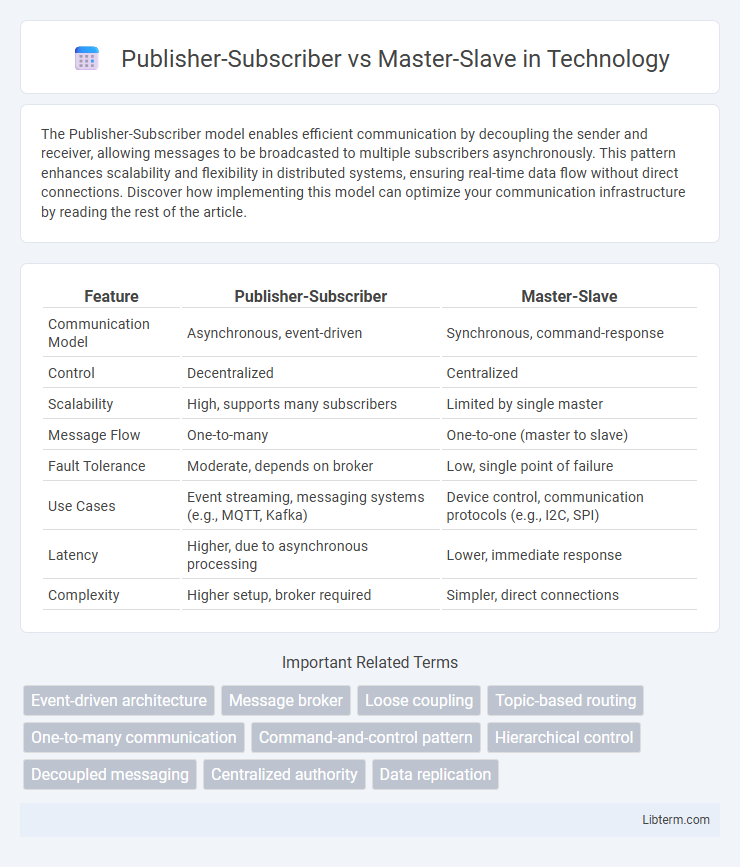The Publisher-Subscriber model enables efficient communication by decoupling the sender and receiver, allowing messages to be broadcasted to multiple subscribers asynchronously. This pattern enhances scalability and flexibility in distributed systems, ensuring real-time data flow without direct connections. Discover how implementing this model can optimize your communication infrastructure by reading the rest of the article.
Table of Comparison
| Feature | Publisher-Subscriber | Master-Slave |
|---|---|---|
| Communication Model | Asynchronous, event-driven | Synchronous, command-response |
| Control | Decentralized | Centralized |
| Scalability | High, supports many subscribers | Limited by single master |
| Message Flow | One-to-many | One-to-one (master to slave) |
| Fault Tolerance | Moderate, depends on broker | Low, single point of failure |
| Use Cases | Event streaming, messaging systems (e.g., MQTT, Kafka) | Device control, communication protocols (e.g., I2C, SPI) |
| Latency | Higher, due to asynchronous processing | Lower, immediate response |
| Complexity | Higher setup, broker required | Simpler, direct connections |
Introduction to Communication Architectures
Publisher-Subscriber and Master-Slave represent fundamental communication architectures used in distributed systems to manage data exchange and control flow. Publisher-Subscriber architecture enables asynchronous communication by decoupling senders and receivers, allowing multiple subscribers to receive updates from publishers without direct connections. Master-Slave architecture structures communication through a central master device that controls one or more slave devices, ensuring synchronized operations and consistent command execution within hierarchical networks.
Defining Publisher-Subscriber Model
The Publisher-Subscriber model is a messaging pattern where publishers send messages without knowledge of subscribers, allowing asynchronous, decoupled communication ideal for dynamic, scalable systems. Subscribers express interest in specific message topics or channels, receiving updates only for relevant events, which enhances flexibility and reduces system complexity. This contrasts with the Master-Slave model, where the master node controls and synchronizes slaves, resulting in tightly coupled, hierarchical interactions.
Understanding Master-Slave Architecture
Master-Slave architecture involves a central master device that controls one or more slave devices, coordinating tasks and data flow to ensure synchronization and hierarchical command execution. This model offers straightforward control and reliability in scenarios requiring strict sequencing, such as industrial automation and database replication. Unlike Publisher-Subscriber systems, where communication is decoupled and asynchronous, Master-Slave emphasizes direct, synchronous interactions with clearly defined command and response roles.
Core Principles: Decoupling vs. Control
The Publisher-Subscriber model emphasizes decoupling by allowing publishers to send messages without knowledge of subscribers, fostering scalable and flexible communication. In contrast, the Master-Slave architecture prioritizes control, where the master directs the operations and slaves respond to commands, ensuring centralized management and synchronization. These core principles distinctly influence system design, with Publisher-Subscriber enhancing modularity and Master-Slave enforcing hierarchical control.
Data Flow Patterns in Both Models
Publisher-Subscriber architecture enables asynchronous, many-to-many data flow, where publishers send messages to topics without direct knowledge of subscribers, supporting dynamic and scalable communication. Master-Slave model follows a synchronous, one-to-many data flow, with the master node controlling communication and synchronization, dictating commands to slave nodes in a hierarchical manner. These patterns impact system design by balancing decoupling and control, with Publisher-Subscriber optimizing for flexibility and Master-Slave for deterministic coordination.
Scalability and Flexibility Comparison
Publisher-Subscriber architecture offers superior scalability by decoupling message producers and consumers, allowing dynamic addition of subscribers without impacting publishers, which enhances system flexibility. Master-Slave architecture relies on a hierarchical control model where the master coordinates slaves, often resulting in bottlenecks and limited scalability due to rigid dependencies. The Publisher-Subscriber model supports diverse and evolving communication patterns with asynchronous message delivery, making it more adaptable to complex, distributed systems compared to the synchronous, tightly-coupled Master-Slave approach.
Fault Tolerance and Reliability
Publisher-Subscriber architecture enhances fault tolerance and reliability by decoupling message producers and consumers, enabling asynchronous communication and dynamic message routing that mitigates single points of failure. Master-Slave configurations rely on a primary node for control, and though failover mechanisms exist, the system's reliability is contingent on the efficiency of master detection and slave promotion processes. Distributed message brokers with Publisher-Subscriber models, such as Apache Kafka, demonstrate higher resilience under node failures compared to traditional Master-Slave replication in databases like MySQL.
Use Cases: When to Use Each Model
Publisher-Subscriber excels in use cases requiring asynchronous communication and scalability, such as real-time event streaming, notification systems, and distributed sensor networks. Master-Slave suits scenarios demanding centralized control and sequential processing, including database replication, device control in embedded systems, and fault-tolerant clustering. Choosing between them depends on factors like latency tolerance, system complexity, and the need for decoupling between components.
Performance and Latency Considerations
Publisher-Subscriber architecture excels in real-time data distribution by enabling multiple subscribers to receive updates simultaneously, minimizing latency through asynchronous communication. Master-Slave models often introduce bottlenecks due to sequential command execution and dependency on the master's processing speed, resulting in higher latency and limited scalability. Performance in Publisher-Subscriber systems benefits from decoupled components and parallelism, whereas Master-Slave designs suffer from potential single points of failure and reduced throughput under heavy loads.
Future Trends in Messaging Architectures
Future trends in messaging architectures emphasize scalability and decoupling, making Publisher-Subscriber models preferable for real-time, distributed systems due to their asynchronous communication and event-driven design. Master-Slave architectures, while simpler, face limitations in flexibility and fault tolerance as systems grow more complex. Emerging technologies like edge computing and IoT increasingly leverage Publisher-Subscriber patterns to enable dynamic, resilient data flow across diverse devices and networks.
Publisher-Subscriber Infographic

 libterm.com
libterm.com